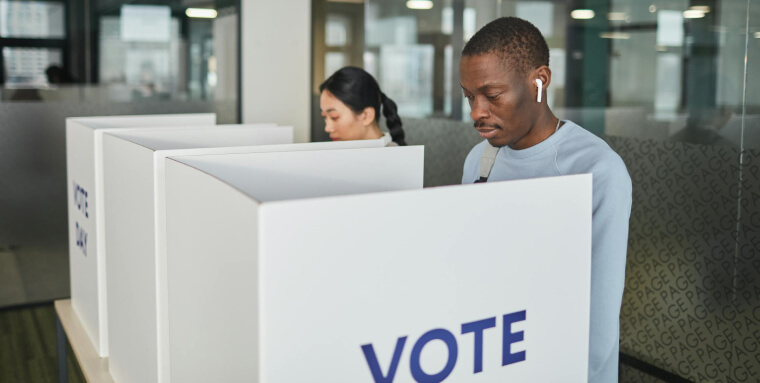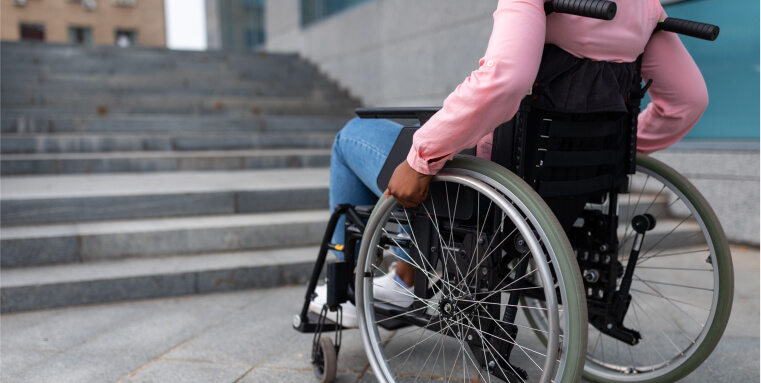Uncommon accessibility issues you may not be aware of

Inaccessible voting booths
Even if the physical buildings in which votes are cast are accessible, the actual voting process will not automatically be considered accessible. The voting booths themselves need to be inspected so that they do not present people with certain disabilities with digital barriers. There are over thirty-eight million eligible voters with disabilities in the United States alone.
A person's vote should remain anonymous, and yet millions of voters are discouraged by the lack of accessibility and privacy at voting booths. For example, individuals with vision impairments or reading and processing disorders may need assistance filling out their ballots, and wheelchair users need ample space to navigate.
Maintaining the elements that render a voting machine accessible and keeping in mind the best practices for assisting individuals with disabilities in the voting process can make privacy less of a barrier to exercising one's right to vote.
For a complete list of action items required under the ADA, press here.
Environments that cause sensory overload
Spaces with overwhelming noise or visual stimuli can be inaccessible for people with autism or sensory processing disorders. Crowded stores, theaters, and sports arenas inherently come with increased sound and visual stimuli.
Business owners should consider offering sensory-conscious hours for shopping or dedicated viewing times. Designated quiet spaces can also offer relief to visitors with these sensory processing disorders.
Service animal restrictions
Some public and private spaces still unlawfully restrict access to service animals. These restrictions can take the form of a complete denial of access to an area or service, along with more minor measures, such as charging people who use a service animal additional fees for cleaning. Ride-share and transportation companies are frequent offenders of denying service animal users access to their services.
As defined by the Americans with Disabilities Act, service animal refers to "any dog that is individually trained to do work or perform tasks for the benefit of an individual witThese service animals make it possible for users to access daily activities with greater ease.
Denying a service animal invariably means that a service animal user is also denied access.
For the ADA’s instructions on service animal users’ rights, press here.
Inaccessible pedestrian signals
Lack of tactile or auditory cues at crosswalks can make travel difficult. The installation of detectable warnings and audible crossing signals can ensure that people with disabilities can navigate through their communities safely.
Limited tactile art and exhibits
Museums and galleries often lack tactile or auditory experiences for visitors with vision impairments. Due to the value, age, and nature of some paintings and artifacts, certain patrons of the arts with color blindness, for example, cannot fully access some exhibits and items.
Creating audible tours and providing procedures for accessing tactile art can remove this barrier. Many museums and art galleries implement programs such as accessible tours during which patrons can wear gloves and other protective gear to touch and explore an exhibit.
Examples of museums providing such tours include the American Museum of Natural History and the Guggenheim Museum in New York.
Uneven flooring and surfaces
Many public spaces, especially outdoor areas and older buildings, have uneven surfaces or sudden changes in flooring.
This can be challenging for wheelchair users or those with mobility issues. Balancing on differing surfaces can prove to be a barrier to accessing these places.
Being mindful of carpet placement, uneven flooring, and slick surfaces such as tiling can help a business plan for improved accessibility.
Lack of seating in public areas
The absence of adequate seating in places like malls, parks, and bus stops can make it difficult for elderly individuals or those with fatigue-related conditions to rest. Ensuring that there is adequate, readily available seating will ensure this group is accommodated for.
High-frequency lighting
Some lighting technologies, especially older fluorescent lights, can flicker at a high frequency. This can be problematic for individuals with conditions like photosensitive epilepsy, migraines, or autism, making such environments uncomfortable or even hazardous for them.
Strobe and other forms of flashing lights commonly found at theaters or concerts can also be unexpected hazards.
Updating light bulbs and providing warnings before performances with flashing lights can ensure the safety and comfort of all visitors.
Scent-heavy environments
Places that use strong fragrances, such as certain stores or public events, can be inaccessible for individuals with multiple chemical sensitivity (MCS) or certain allergies, causing them respiratory distress or other reactions.
Under Title III of the Americans with Disabilities Act, buildings are required to accommodate people with disabilities, including sensory disorders.
Many brands offer fragrance-free cleaning products and air fresheners. Using these alternatives would eliminate the barrier of overpowering fragrances that can be triggering to some visitors and prevent them from accessing a store or service.
Temperature-regulated spaces
Some individuals, especially those with conditions like multiple sclerosis or certain types of neuropathy, can be sensitive to extreme temperatures. Venues that don’t offer a stable, moderate temperature can be challenging for them to access and remain in comfortably.
Consider maintaining an average temperature controlled by a thermostat or other device to avoid this issue.
Common real-world accessibility issues

Lack of ramps and elevators
A lack of ramps or elevators can pose a significant physical barrier for wheelchair users and those with limited mobility. The location of ramps and elevators is also key in making spaces accessible.
Title III of the Americans with Disabilities Act requires “existing, altered, and newly constructed places of public accommodation, such as retail stores, hotels, restaurants, movie theaters, and stadiums, to make their facilities readily accessible to and usable by individuals with disabilities, which includes individuals with sensory disabilities, so that individuals with disabilities have a full and equal opportunity to enjoy the benefits of a public accommodation's goods, services, facilities, privileges and advantages."
For the full list of instructions and requirements pertaining to the provision of ramps and elevators under the ADA, press here.
Inadequate signage
The absence of braille or large print signs can restrict access for people with vision impairments. To be considered compliant with the Americans with Disabilities Act, buildings must adhere to strict building code guidelines.
These include the incorporation of accessible signage such as braille and large print in elevator, office, restroom, and storage and staircase signs.
For the full list of instructions and requirements pertaining to effective communication under the ADA, press here.
Non-auditory public announcements
Lack of visual cues in public transport and buildings can exclude people who are deaf or hard of hearing. To be most accessible, both cues, auditory and visual, should be present at places such as transportation buildings and sports stadiums.
People with vision and hearing impairments make up an estimated two-thirds of the disability community, and their rights must be guaranteed.
Inaccessible public transportation
Buses or trains without low floors or audio announcements are inaccessible to people with mobility-related disabilities. As public services, transportation falls under the Americans with Disabilities Act which contains guidelines for making public transportation accessible.
Limited accessible parking
Insufficient or poorly located accessible parking spots are a common issue. Accessible parking spaces should be located closest to the building or park entrance.
For the full list of instructions and requirements pertaining to the provision of accessible parking spots under the ADA, press here.
Inaccessible restrooms
Lack of grab bars, high sinks, or adequate space for wheelchair users prohibit people with disabilities from accessing them.
As a facility open to the public, restrooms should be made accessible or organizations risk being noncompliant with the Americans with Disabilities Act.
For the full list of instructions and requirements pertaining to the provision of accessible restrooms under the ADA, press here.
Inaccessible medical equipment
Examination tables and diagnostic equipment that aren't adjustable do not accommodate those with physical disabilities.
Accessibility in healthcare settings is a serious concern as it creates a barrier for people with disabilities who may have difficulty accessing medical services.
Medical offices and healthcare facilities are public services and are therefore required by the Americans with Disabilities Act to make accommodations for visitors with disabilities, such as adjustable medical equipment and accessible information.
Lack of sign language interpreters
In healthcare facilities, legal settings, and public events, a lack of sign language interpreters prevents people who are deaf or hard of hearing from accessing information.
Under the Americans with Disabilities Act, these public places and services are required by law to accommodate people with disabilities.
Inaccessible workstations
Workplaces not equipped for people with mobility or sensory impairments can be unusable. Employers are required to make reasonable accommodations and adjustments to working conditions for employees with disabilities to complete their jobs.
Reasonable accommodations can include adjustable desks, chairs, and space for assistive technology and mobility aids. As these are public areas used for employment, they need to be compliant with the Americans with Disabilities Act and building code requirements.
Inadequate emergency services
The lack of accessible emergency warning systems and evacuation plans is unsafe for people with disabilities. Title II of the Americans with Disabilities Act requires emergency services, including telephone systems, plans, and first responders to be accessible and accommodating for people with disabilities.
Providing braille and large-print signage on emergency exits, conducting drills, and making emergency announcements clear and accessible in varying modes will eliminate unsafe and inaccessible systems and plans.
Common web and digital accessibility issues

Missing alt text for meaningful images
Meaningful images appearing in websites and web-based applications (like PDFs) should include alternative text that clearly and concisely describes the content of the image.
An image is considered meaningful if it contains relevant and critical information. Decorative images (i.e., the kind that do not contain critical information) should be hidden from assistive technology. One way of ensuring this is by not adding alt text to these images.
Auto-playing and time-based media
Unexpected audio or video can be disorienting for people with cognitive disabilities, as well as those who rely on their hearing to access information.
Content that disappears after a set time can be inaccessible for those who need more time to read or interpret information to interact with elements on a web page. Therefore, website visitors and users should be clearly notified regarding existing time constraints with the media they are accessing.
Additionally, they should be able to extend the time frame in which media will expire.
Lack of tactile feedback
People with hearing and vision impairments using smart phones rely on sensory feedback such as vibration patterns to navigate through applications. Many applications do not provide tactile feedback and are therefore inaccessible to a VoiceOver (iPhone) or TalkBack (Android) user.
Insufficient color contrast
Text and background colors that do not provide enough contrast can inhibit a user's ability to access information as well as interact with web page controls.
People with low vision or color blindness need to be able to access all elements of a website. Under WCAG, a minimum color contrast of 4.5:1 is required for most text and its background. For more information regarding accessible color contrasts, you can press here.
Non-responsive design
Websites that don't adapt to various screen sizes can limit methods of accessing the information by adding restrictions to font size and the number of items displayed. WCAG 2.1 Guidelines 1.4.4 Resize Text and 2.4.5 Multiple Ways offer specifics on resizing fonts and multiple ways to access the content.
Lack of compatibility with assistive technologies
Websites that are not compatible with screen readers deny access to people with vision impairments and others who use other assistive technologies. To that end, many website owners rely on accessibility solutions, such as accessWidget.
These tools identify website code that stands in the way of assistive technology compatibility, and then make the necessary adjustments to ensure optimal accessibility. You can learn more about accessWidget by pressing here.
Websites and digital environments that cannot be operated solely via keyboard
WCAG 2.1 Guidelines 2.1.1 Keyboard and 2.1.2 No Keyboard Trap require that a website be accessible by a keyboard. It also requires that use of a keyboard will not create an unusable interface or "keyboard trap."
Videos lacking captions
Captions are added to videos to give access to people with hearing impairments and others who cannot access or process sound. This includes approximately 5% of the population.
Even when added, captions can be inaccurate (especially when auto-generated). WCAG 2.1 Guideline 1.2.2 Captions Pre-Recorded discusses standards for video caption compliance. Testing captions and ensuring that their timing fits within the context of the video's action and dialogue is essential. For more information on captions and video accessibility, you can press here.
Inaccessible PDFs
PDF documents need to be tagged so that screen readers (such as JAWS and NVDA) can properly access them. Tagging provides context to elements within a PDF, enabling screen readers to navigate the document effectively and present its contents in a coherent sequence.
Very often, PDFs aren’t properly tagged.
Additionally, for PDFs to be fully accessible, they must contain other elements, such as alt text for any meaningful images included in them, accurate and descriptive link descriptions, and sufficient color contrast ratios between text and its background. To learn more about creating accessible PDFs, press here.
CAPTCHAs
CAPTCHAs are security measures on websites to stop bots and scams. They ask questions that only humans can answer, ensuring the visitor is real. However, these tests can be tough for those with vision or cognitive impairments.
If using these kinds of tests is absolutely necessary, it is recommended to use Google’s version, reCAPTACHA, as it offers audio versions of a given test, and is generally considered more accessible.
Key takeaways
Both common and uncommon accessibility issues should not be ignored. If left untreated, they discriminate against vast communities. Barriers can take on all forms, including physical barriers such as staircases and lack of braille signage to digital barriers such as insufficient color contrast and lack of alternatives for CAPTCHA images.
Raising awareness of these issues can result in them being properly addressed and fixed, and help to create a society in which people with disabilities are no longer discriminated against.
Frequently asked questions about uncommon accessibility issues
Q1. What are uncommon accessibility issues?
A1. Uncommon accessibility issues are barriers that are not always caught during routine testing, yet still affect how people with disabilities navigate or interpret a website. These issues often appear in complex interactions, third-party components, embedded content, or custom design elements.
Q2. Why are these issues harder to detect?
A2. Many uncommon issues occur only under specific conditions or with certain assistive technologies. Automated tools may not fully capture them, and visual inspection alone often misses barriers that appear during interactive or device-specific scenarios.
Q3. Are uncommon accessibility issues less important than common ones?
A3. No. While they may be less frequent, they can significantly disrupt the user experience for people who encounter them. Identifying and resolving these issues helps ensure a more consistent, equitable experience across the entire site.
Q4. How do uncommon issues affect users with disabilities?
A4. These issues can interrupt navigation, prevent task completion, distort information, or introduce confusion. Because they are unexpected, users may not have alternative strategies to work around them, leading to frustration or abandonment.
Q5. What kinds of website features tend to create uncommon accessibility issues?
A5. Complex widgets, dynamic content, interactive media, custom JavaScript, and embedded third-party components often introduce unusual barriers. These elements may behave differently with assistive technologies or fail to communicate changes effectively.
Q6. Can WCAG guidelines help identify uncommon accessibility issues?
A6. Yes. WCAG provides the foundation for understanding how content should behave for all users. Although uncommon issues are not always obvious, they typically relate to WCAG principles such as operability, predictability, or compatibility.
Q7. Do accessibility audits usually catch these less common issues?
A7. Comprehensive audits that combine automated testing, manual reviews, and real assistive technology testing are more likely to uncover them. A single testing method rarely identifies every barrier, especially in dynamic or highly customized environments.
Q8. Who is responsible for addressing uncommon accessibility issues?
A8. Responsibility is typically shared between designers, developers, content creators, and product owners. Ensuring that complex interactions and custom components are reviewed consistently helps prevent uncommon issues from going unnoticed.
Q9. How can organizations reduce the likelihood of these issues appearing?
A9. Building accessibility into design and development processes from the beginning, testing with assistive technologies, and reviewing updates before publishing can all reduce the occurrence of unexpected barriers.
Q10. How can accessiBe help organizations identify and address uncommon accessibility issues?
A11. accessiBe offers end-to-end accessibility solutions that combine AI-driven insights, human expertise, and developer tools. accessFlow, an accessibility management platform for developers, provides in-depth audits, continuous monitoring, and detailed remediation workflows that help teams uncover and resolve both common and uncommon accessibility issues more effectively. accessWidget enhances the user experience by offering session-based accessibility adjustments and AI-powered background remediation that supports screen readers and keyboard navigation. accessServices delivers expert-led accessibility support, including audits, document remediation, multimedia accessibility, user testing, and guidance for organizations working to meet their accessibility and compliance goals.





